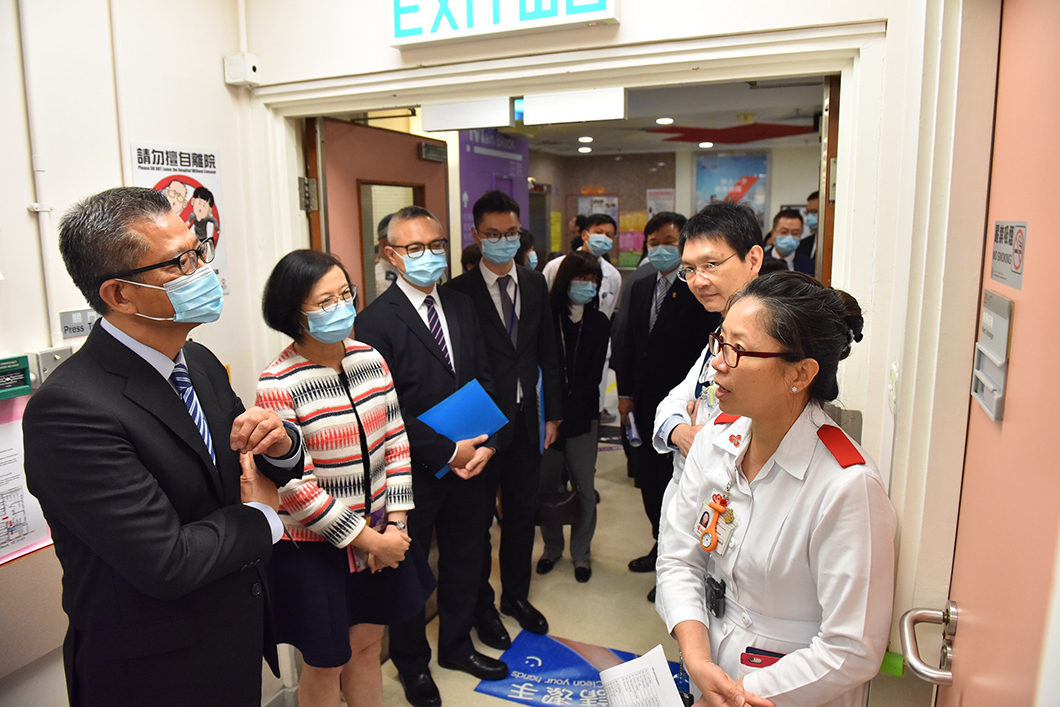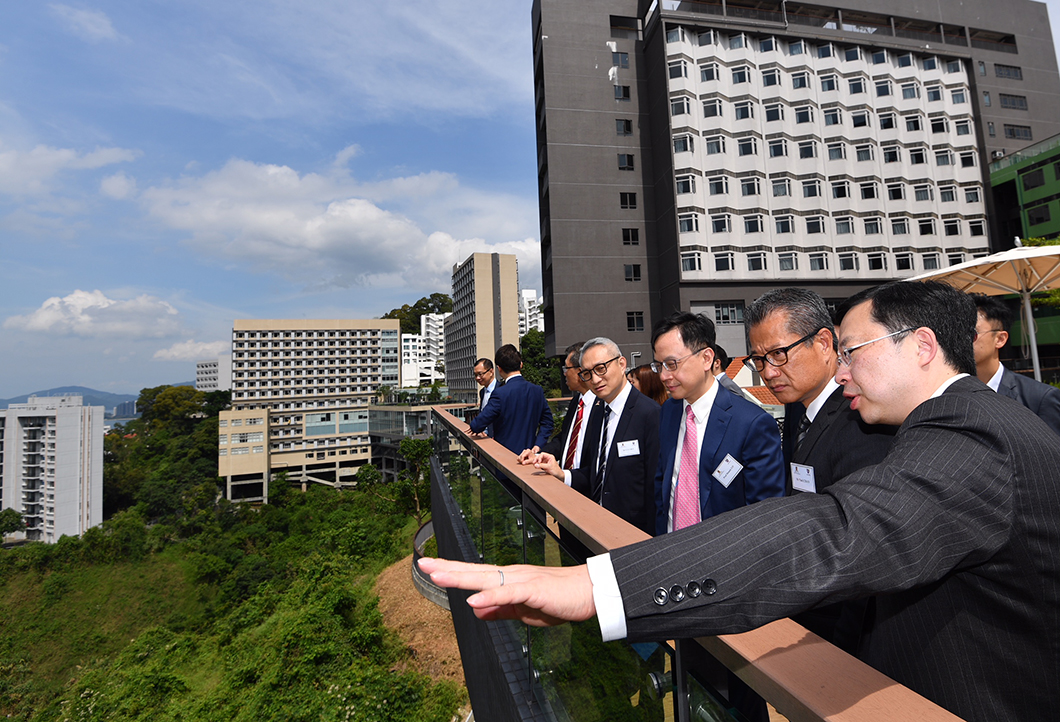Blog
Multi-pronged approach to handle problem proactively
With an ageing population, demand on public healthcare services in Hong Kong has been increasing. Before the COVID-19 outbreak, our public healthcare system had been already facing a tremendous pressure. The long waiting time at the accident and emergency departments and the overloaded occupancy rates of wards during past outbreaks of influenza had aroused wide public concern. In view of this, in my last few Budgets, I dedicated extra resources to both the hardware and software of the healthcare system with a view to alleviating the bottlenecks in manpower and related facilities. Expenditure on public health over the past few years surged from HK$ 71.1 billion in 2017-18 to HK$ 115.8 billion in 2021-22, i.e. a 65% increase in four years’ time. Public healthcare constitutes a significant part of the Government spending, taking up a portion similar to that of social welfare and education.
In terms of hardware, we have been pressing ahead with the two “10-year Hospital Development Plan” (HDP) to provide more beds and upgrade the hospital facilities. For the first 10-year HDP, HK$200 billion has been earmarked and various projects are under way. The whole plan is expected to provide a total of over 6 000 additional beds and more than 90 operating theatres. I announced the second 10-year HDP in my 2018-19 Budget, which included the redevelopment of Princess Margaret Hospital and Tuen Mun Hospital, and the expansion of Queen Elizabeth Hospital and North Lantau Hospital. The entire plan is expected to provide over 9 000 additional beds and other new hospital facilities, meeting the projected service demand up to 2036. Apart from the two HDPs, we have earmarked HK$ 5 billion for the acquisition of medical equipment, including advanced medical devices for treating cancer and other diseases requiring specialty services.

|
| In recent years, I visited hospitals to learn more about the working environment of the frontline staffs and their needs in resources. |
Apart from hardware, our shortage in medical manpower is equally severe. Currently, Hong Kong has a ratio of two doctors per 1 000 population, which lags far behind other advanced economies such as Singapore, the UK and the US. According to the “Healthcare Manpower Projection 2020”, the shortage of doctors will get further worsen in the medium to long term. The current shortage of manpower in our public healthcare system is even more imminent. We have to take decisive actions to tackle the problem so as to alleviate the pressure on the public healthcare system and shorten the waiting time of patients. One of the solutions is to increase the number of locally trained doctors. We have substantially increased the number of medical training places from an annual average of 250 during the period of 2005-06 to 2008-09 to 530 in 2021-22, representing an increase of more than one-fold. We also plan to further increase the number of medical training places. At the same time, we pledged in the 2018-19 Budget to provide adequate resources to the Hospital Authority (HA) for employing all local medical graduates, so that our young medical students could focus on their studies without needs to worry about finding jobs in future.
To enhance the capacity of the whole public healthcare services, apart from increasing the training places for doctors, it is also necessary to train more pharmacists, physical therapists and nurses, and enhance the teaching facilities. I visited a few tertiary institutions providing training to local medical professions in the past few years to learn more about their needs in teaching facilities. In the past two financial years, around $1.9 billion has been allocated to the University of Hong Kong, the Chinese University of Hong Kong and the Hong Kong Polytechnic University for carrying out short term renovation and enhancement works, as well as feasibility studies and medium to long term works projects to expend their teaching facilities. This helps to ensure that the training of local medical professions will not be constrained by teaching supporting facilities.
And in view of the increasing workload on the frontline staff of our public healthcare system, I have allocated resources for the HA in my recent Budgets to implement a series of targeted measures to retain talent. These include raising the various allowances for the frontline staff, enhancing the scheme of rehiring retired staff, and creating more promotion and training opportunities. The additional expenditure involved is expected to increase by more than 6 times from around HK$ 160 million in 2021-22 to around HK$ 1.2 billion in 2025-26.

|
| I also visited a few tertiary institutions providing training to local medical professions to learn more about their needs in teaching facilities. Funding has been provided for them to upgrade the facilities. |
Though we have increased the number of training places and enhanced the teaching facilities, it still takes more than ten years to train a specialist doctor. Such medium to long term measures for increasing doctors could not instantly relieve the manpower shortage problem in the public healthcare system and address people’s imminent healthcare needs. We therefore need to adopt a multi-pronged approach with effective short term measures in tackling the problem.
Last week, the SAR Government proposed to amend the Medical Registration Ordinance to create a new pathway of “special registration” other than the existing registration mechanism, with a view to allowing non-locally trained doctors to apply for full registration after fulfilling a set of criteria. The required criteria for the applicants include: (1) being a Hong Kong Permanent Resident (HKPR); (2) holding a medical qualification recognised by the SAR Government; (3) full-time employed in any of the public healthcare institutions in Hong Kong for five to eleven years, and being considered by the employing institutions to have served satisfactorily. As for the actual serving period in the public institutions, it depends on whether the applicant have obtained specialist qualification before joining the institution. If the applicant is a fresh graduate from a medical degree, he/she will have to go through specialist training in Hong Kong public institutions for at least six years, and serve in the institutions for at least another five years after obtaining the specialist qualification in order to be fully registered.
This arrangement provides an option for non-locally trained HKPR doctors, who are familiar with the Hong Kong environment, to relocate to Hong Kong and serve in our public healthcare institutions, so as to help relieve the manpower pressure on our public healthcare system. The continuous performance assessment during the employment period in public healthcare institutions could also help ensure the quality of these doctors.
Looking at overseas experience, Singapore has been facing similar shortage in manpower in recent years. Since 2003, they set up a similar arrangement for the admission of overseas doctors and gradually recognised the qualifications of medical graduates from over a hundred of international medical schools. By offering a limited registration, the overseas doctors are allowed to work in the hospitals and could obtain full registration after being assessed by senior doctors. The merits of the arrangement is that the admission of overseas doctors can be expedited to alleviate the pressure of manpower shortage with quality safeguards.
The admission of non-locally trained doctors indeed is not something new to Hong Kong. Back in the 1990s, non-locally trained doctors accounted for about 45% of newly registered doctors in Hong Kong at that time. However, over the past decade (2011 to 2020), that ratio dropped significantly to about 10%, deteriorating the manpower shortage problem in our healthcare system.
Facing the persistent problem of shortage of doctors in our public healthcare system, we have already allocated extra resources in both software and hardware enhancement, with a view to solving the problem in the medium to long term. To tackle the manpower shortage in the short run, the current proposal would be the most appropriate option by drawing non-locally trained HKPR doctors to serve in our public healthcare system. I appeal you all to support the legislative amendment proposal for the overall benefit of our society.
May 23, 2021